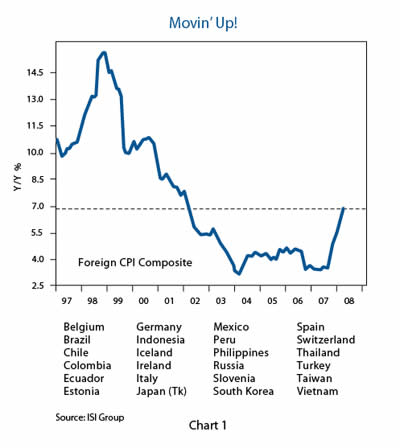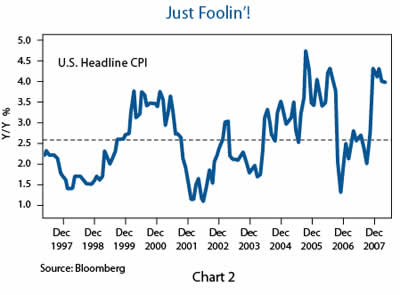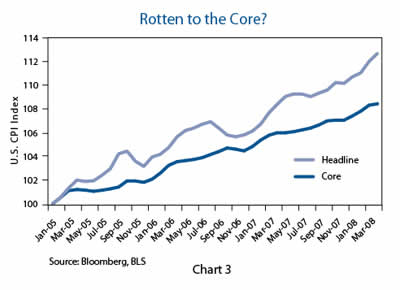Importance of Real US Inflation Rate in Forming Investment Decisions
Stock-Markets / Inflation Jun 10, 2008 - 03:28 AM GMTBy: John_Mauldin
 This week in Outside the Box we look at Bill Gross's recent essay on measuring inflation. How you measure inflation makes a difference not only in social security payments but also in what your real returns on bonds are. As Bill notes, there is a significant difference in how the world measures inflation and how it is done in the US. He gives us some insights that are very thought-provoking.
This week in Outside the Box we look at Bill Gross's recent essay on measuring inflation. How you measure inflation makes a difference not only in social security payments but also in what your real returns on bonds are. As Bill notes, there is a significant difference in how the world measures inflation and how it is done in the US. He gives us some insights that are very thought-provoking.
In the last decade economists regularly argued the CPI over-stated inflation by 1%. Now Gross suggests that it may understate inflation by 1%. This week's OTB makes for very interesting reading. Bill Gross is managing director of PIMCO. (www.pimco.com)
John Mauldin, Editor , Outside the Box
Fooling With Inflation
by Bill Gross
You can fool some of the people all of the time,
and all of the people some of the time,
but you cannot fool all of the people all of the time.
- Abraham Lincoln
What this country needs is either a good 5¢ cigar or the reincarnation of an Illinois "rail-splitter" willing to tell the American people "what up" – "what really up." We have for so long now been willing to be entertained rather than informed, that we more or less accept majority opinion, perpetually shaped by ratings obsessed media, at face value. After 12 months of an endless primary campaign barrage, for instance, most of us believe that a candidate's preacher – Democrat or Republican – should be a significant factor in how we vote. We care more about who's going to be eliminated from this week's American Idol than the deteriorating quality of our healthcare system. Alternative energy discussion takes a bleacher's seat to the latest foibles of Lindsay Lohan or Britney Spears and then we wonder why gas is four bucks a gallon. We care as much as we always have – we just care about the wrong things: entertainment, as opposed to informed choices; trivia vs. hardcore ideological debate.
It's Sunday afternoon at the Coliseum folks, and all good fun, but the hordes are crossing the Alps and headed for modern day Rome – better educated, harder working, and willing to sacrifice today for a better tomorrow. Can it be any wonder that an estimated 1% of America's wealth migrates into foreign hands every year? We, as a people, are overweight, poorly educated, overindulged, and imbued with such a sense of self importance on a geopolitical scale, that our allies are dropping like flies. "Yes we can?" Well, if so, then the "we" is the critical element, not the leader that will be chosen in November. Let's get off the couch and shape up – physically, intellectually, and institutionally – and begin to make some informed choices about our future. Lincoln didn't say it, but might have agreed, that the worst part about being fooled is fooling yourself, and as a nation, we've been doing a pretty good job of that for a long time now.
I'll tell you another area where we've been foolin' ourselves and that's the belief that inflation is under control. I laid out the case three years ago in an Investment Outlook titled, " Haute Con Job ." I wasn't an inflationary Paul Revere or anything, but I joined others in arguing that our CPI numbers were not reflecting reality at the checkout counter. In the ensuing four years, the debate has been joined by the press and astute authors such as Kevin Phillips whose recent Bad Money is as good a summer read detailing the state of the economy and how we got here as an "informed" American could make.
 Let me reacquaint you with the debate about the authenticity of U.S. inflation calculations by presenting two ten-year graphs – one showing the ups and downs of year-over-year price changes for 24 representative foreign countries, and the other, the same time period for the U.S. An observer's immediate take is that there are glaring differences, first in terms of trend and second in the actual mean or average of the 2 calculations. These representative countries, chosen and graphed by Ed Hyman and ISI, have averaged nearly 7% inflation for the past decade, while the U.S. has measured 2.6%. The most recent 12 months produces that same 7% number for the world but a closer 4% in the U.S.
Let me reacquaint you with the debate about the authenticity of U.S. inflation calculations by presenting two ten-year graphs – one showing the ups and downs of year-over-year price changes for 24 representative foreign countries, and the other, the same time period for the U.S. An observer's immediate take is that there are glaring differences, first in terms of trend and second in the actual mean or average of the 2 calculations. These representative countries, chosen and graphed by Ed Hyman and ISI, have averaged nearly 7% inflation for the past decade, while the U.S. has measured 2.6%. The most recent 12 months produces that same 7% number for the world but a closer 4% in the U.S.
This, dear reader, looks a mite suspicious. Sure, inflation was legitimately much higher in selected hot spots such as Brazil and Vietnam in the late 90s and the U.S. productivity "miracle" may have helped reduce ours a touch compared to some of the rest, but the U.S. dollar over the same period has declined by 30% against a currency basket of its major competitors which should have had an opposite effect, everything else being equal. I ask you: does it make sense that we have a 3% – 4% lower rate of inflation than the rest of the world? Can economists really explain this with their contorted Phillips curve, output gap, multifactor productivity theorizing in an increasingly globalized "one price fits all" commodity driven global economy? I suspect not. Somebody's been foolin', perhaps foolin' themselves – I don't know. This isn't a conspiracy blog and there are too many statisticians and analysts at the Bureau of Labor Statistics (BLS) and Treasury with rapid turnover to even think of it. I'm just concerned that some of the people are being fooled all of the time and that as an investor, an accurate measure of inflation makes a huge difference.

The U.S. seems to differ from the rest of the world in how it computes its inflation rate in three primary ways: 1) hedonic quality adjustments, 2) calculations of housing costs via owners' equivalent rent, and 3) geometric weighting/product substitution. The changes in all three areas have favored lower U.S. inflation and have taken place over the past 25 years, the first occurring in 1983 with the BLS decision to modify the cost of housing. It was claimed that a measure based on what an owner might get for renting his house would more accurately reflect the real world – a dubious assumption belied by the experience of the past 10 years during which the average cost of homes has appreciated at 3x the annual pace of the substituted owners' equivalent rent (OER), and which would have raised the total CPI by approximately 1% annually if the switch had not been made.
In the 1990s the U.S. CPI was subjected to three additional changes that have not been adopted to the same degree (or at all) by other countries, each of which resulted in downward adjustments to our annual inflation rate. Product substitution and geometric weighting both presumed that more expensive goods and services would be used less and substituted with their less costly alternatives: more hamburger/less filet mignon when beef prices were rising, for example. In turn, hedonic quality adjustments accelerated in the late 1990s paving the way for huge price declines in the cost of computers and other durables. As your new model MAC or PC was going up in price by a hundred bucks or so, it was actually going down according to CPI calculations because it was twice as powerful. Hmmmmm? Bet your wallet didn't really feel as good as the BLS did.
In 2004, I claimed that these revised methodologies were understating CPI by perhaps 1% annually and therefore overstating real GDP growth by close to the same amount. Others have actually tracked the CPI that "would have been" based on the good old fashioned way of calculation. The results are not pretty, but are undisclosed here because I cannot verify them. Still, the differences in my 10-year history of global CPI charts are startling, aren't they? This in spite of a decade of financed-based, securitized, reflationary policies in the U.S. led by the public and private sector and a declining dollar. Hmmmmm?
In addition, Fed policy has for years focused on "core" as opposed to "headline" inflation, a concept actually initiated during the Nixon Administration to offset the sudden impact of OPEC and $12 a barrel oil prices! For a few decades the logic of inflation's mean reversion drew a fairly tight fit between the two measures, but now in a chart shared frequently with PIMCO's Investment Committee by Mohamed El-Erian, the divergence is beginning to raise questions as to whether "headline" will ever drop below "core" for a sufficiently long period of time to rebalance the two. Global commodity depletion and a tightening of excess labor as argued in El-Erian's recent Secular Outlook summary suggest otherwise.

The correct measure of inflation matters in a number of areas, not the least of which are social security payments and wage bargaining adjustments. There is no doubt that an artificially low number favors government and corporations as opposed to ordinary citizens. But the number is also critical in any estimation of bond yields, stock prices, and commercial real estate cap rates. If core inflation were really 3% instead of 2%, then nominal bond yields might logically be 1% higher than they are today, because bond investors would require more compensation. And although the Gordon model for the valuation of stocks and real estate would stress "real" as opposed to nominal inflation additive yields, today's acceptance of an artificially low CPI in the calculation of nominal bond yields in effect means that real yields – including TIPS – are 1% lower than believed. If real yields move higher to compensate, with a constant equity risk premium, then U.S. P/E ratios would move lower. A readjustment of investor mentality in the valuation of all three of these investment categories – bonds, stocks, and real estate – would mean a downward adjustment of price of maybe 5% in bonds and perhaps 10% or more in U.S. stocks and commercial real estate.
A skeptic would wonder whether the U.S. asset-based economy can afford an appropriate repricing or the BLS was ever willing to entertain serious argument on the validity of CPI changes that differed from the rest of the world during the heyday of market-based capitalism beginning in the early 1980s. It perhaps was better to be "entertained" with the notion of artificially low inflation than to be seriously "informed." But just as many in the global economy are refusing to mimic the American-style fixation with superficialities in favor of hard work and legitimate disclosure, investors might suddenly awake to the notion that U.S. inflation should be and in fact is closer to worldwide levels than previously thought. Foreign holders of trillions of dollars of U.S. assets are increasingly becoming price makers not price takers and in this case the price may not be right. Hmmmmm?
What are the investment ramifications? With global headline inflation now at 7% there is a need for new global investment solutions, a role that PIMCO is more than willing (and able) to provide. In this role we would suggest: 1) Treasury bonds are obviously not to be favored because of their negative (unreal) real yields. 2) U.S. TIPS, while affording headline CPI protection, risk the delusion of an artificially low inflation number as well. 3) On the other hand, commodity-based assets as well as foreign equities whose P/Es are better grounded with local CPI and nominal bond yield comparisons should be excellent candidates. 4) These assets should in turn be denominated in currencies that demonstrate authentic real growth and inflation rates, that while high, at least are credible. 5) Developing, BRIC-like economies are obvious choices for investment dollars.
Investment success depends on an ability to anticipate the herd, ride with it for a substantial period of time, and then begin to reorient portfolios for a changing world. Today's world, including its inflation rate, is changing. Being fooled some of the time is no sin, but being fooled all of the time is intolerable. Join me in lobbying for change in U.S. leadership, the attitude of its citizenry, and (to the point of this Outlook ) the market's assumption of low relative U.S. inflation in comparison to our global competitors.
Your watching gas go to $4 in Texas (!) analyst,
John F. Mauldin
johnmauldin@investorsinsight
John Mauldin, Best-Selling author and recognized financial expert, is also editor of the free Thoughts From the Frontline that goes to over 1 million readers each week. For more information on John or his FREE weekly economic letter go to: http://www.frontlinethoughts.com/learnmore
To subscribe to John Mauldin's E-Letter please click here:http://www.frontlinethoughts.com/subscribe.asp
John Mauldin is the President of Millennium Wave Advisors, LLC (MWA) which is an investment advisory firm registered with multiple states. John Mauldin is a registered representative of Millennium Wave Securities, LLC, (MWS) an FINRA registered broker-dealer. MWS is also a Commodity Pool Operator (CPO) and a Commodity Trading Advisor (CTA) registered with the CFTC, as well as an Introducing Broker (IB). Millennium Wave Investments is a dba of MWA LLC and MWS LLC. Millennium Wave Investments cooperates in the consulting on and marketing of private investment offerings with other independent firms such as Altegris Investments; Absolute Return Partners, LLP; Pro-Hedge Funds; and Plexus Asset Management. All material presented herein is believed to be reliable but we cannot attest to its accuracy. Investment recommendations may change and readers are urged to check with their investment counselors before making any investment decisions.
Opinions expressed in these reports may change without prior notice. John Mauldin and/or the staffs at Millennium Wave Advisors, LLC and InvestorsInsight Publishing, Inc. ("InvestorsInsight") may or may not have investments in any funds cited above. Disclaimer PAST RESULTS ARE NOT INDICATIVE OF FUTURE RESULTS. THERE IS RISK OF LOSS AS WELL AS THE OPPORTUNITY FOR GAIN WHEN INVESTING IN MANAGED FUNDS. WHEN CONSIDERING ALTERNATIVE INVESTMENTS, INCLUDING HEDGE FUNDS, YOU SHOULD CONSIDER VARIOUS RISKS INCLUDING THE FACT THAT SOME PRODUCTS: OFTEN ENGAGE IN LEVERAGING AND OTHER SPECULATIVE INVESTMENT PRACTICES THAT MAY INCREASE THE RISK OF INVESTMENT LOSS, CAN BE ILLIQUID, ARE NOT REQUIRED TO PROVIDE PERIODIC PRICING OR VALUATION INFORMATION TO INVESTORS, MAY INVOLVE COMPLEX TAX STRUCTURES AND DELAYS IN DISTRIBUTING IMPORTANT TAX INFORMATION, ARE NOT SUBJECT TO THE SAME REGULATORY REQUIREMENTS AS MUTUAL FUNDS, OFTEN CHARGE HIGH FEES, AND IN MANY CASES THE UNDERLYING INVESTMENTS ARE NOT TRANSPARENT AND ARE KNOWN ONLY TO THE INVESTMENT MANAGER.
© InvestorsInsight Publishing, Inc. 2008 ALL RIGHTS RESERVED
John Mauldin Archive |
© 2005-2022 http://www.MarketOracle.co.uk - The Market Oracle is a FREE Daily Financial Markets Analysis & Forecasting online publication.



